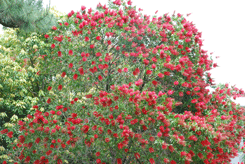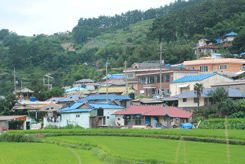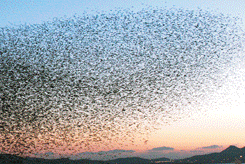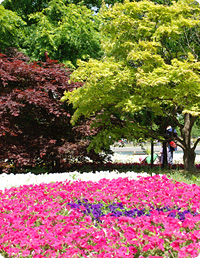Flora & Fauna
 |
 |
 |
Korea is botanically divided into five districts each with special difference: Jeju island, Southern, Central, Northern Districts and Ulleungdo, an island east of the peninsula. A great variety of flora, pine, larch, spruce, juniper, oak, willow, maple, alder and birch trees, usual in temperate climates are found over the whole peninsula. Also large gingko and Chinese elm are scattered throughout the country.
Flowering shrubs are numerous and grow profusely on the hillsides, such as forsythia, azalea, cherry, lilac, syringe and spiraea and many other varieties of wildflowers. The cypress, beech, maple and paulownia are found on Ulleung Island. The soil and climate of Korea have proved most suitable for the cultivation of fruit trees and there are large orchards of apples, pears, peaches, and vine fruits.
The walnut, chestnut and pine nut as well as persimmon are indigenous and produce good crops. Oranges, Kiwis, dragon fruits and tangerines are now grown in the south. 4,159 species of plant have been recorded.
Animals found on the peninsula are the boar, bear, deer, wildcat, wolf, hare, weasel, lynx, marten, roe deer, water deer, goat, musk deer, badger, racoon, otter, mole, bat and chipmunk though now some of these animals are rare except in the mountains of Korea.
There are a large number of rodents in South Korea as well, like the red squirrels and the Siberian flying squirrels. When it comes to rats or mice, the harvest mouse and the striped field mouse are quite common. Korean hares can also be found hopping around the forest. There are carnivorous mammals such as cats that are common like the leopards, panthers and tigers. You will also find common canines like the gray wolf and the red fox.
The ungulates are very important to the humans economically that live in South Korea. The native horse is small but strong, while the cattle are large, useful for beef, and widely distributed.
A wide variety of water animals and fish have stimulated a vigorous fishing industry. Snakes of various kinds are found but few are venomous. Insect life has been well studied as many as harmful to trees and crops. Many of the insect groups distributed in Korea belong to the Paleoarctic Region biogeographically as with other animals and plants.
It is known that approximately 12,000 known species of insects currently live in Korea. Two hundred species of butterflies have been identified.
Honey bees have made honey framing an important source of income.
Some 450 species of bird have been recorded in the Korean Peninsula. Though there are many birds around, it is impossible to see all these kinds of birds in a same time of a year, and their habitats are different from each other. The most common native birds are the crow, magpie, jay, kite, heron, crane, oriole, lark, sparrow, robin, tit, pheasant and quail while the migratory birds are black-naped oriole, common cuckoo, barn swallow, egrets, geese, swans, cranes, bustard, ducks, teals, and rails.
As a measure of conservation of Korea's natural environment some flora and fauna have been designated as Protected Natural Resources. There are now over 150 listed natural resources.
Certain birds such as Tristram Woodpecker, Crested Ibis, Black Stork, Blackfaced Spoonbill and Great Bustard are registered and protected. A particular long horned beetle is protected. Jindo dog is protected as a pure breed on Jindo island off the southwest coast of Korea.
Korea's birds deserve a wider audience. The country's geographical location, topography, temperate climate, and wealth of diverse habitats combine to support an extraordinary attractive avifauna. (Source : Korea guide by Edward B. Adams)
Some of the birds that has been recorded in the Korean peninsula are as follow. (Source : Koera through her birds by Robert Newlin)
English |
Korean |
English |
Korean |
|
Grey-headed woodpecker |
청딱다구리 |
White’s thrush |
호랑지빠귀 |
|
Eurasian kestrel |
황조롱이 |
Eurasian sparrowhawk |
새매 |
|
White throated rock thrush |
꼬까직바구리 |
Chestnut bunting |
꼬까참새 |
|
Varied tit |
곤줄박이 |
Stejneger's stonechat |
검은딱새 |
|
Long-tailed tit |
오목눈이 |
Arctic warbler |
쇠솔새 |
|
Alpine accentor |
바위종다리 |
Chestnut-flanked white-eye |
한국동박새 |
|
Chinese grosbeak |
밀화부리 |
Bull-headed shrike |
때까치 |
|
Daurian redstart |
딱새 |
Grey heron |
왜가리 |
|
Oriental scops owl |
소쩍새 |
Brown hawk owl |
솔부엉이 |
|
Yellow-breasted bunting |
검은머리촉새 |
Eagle owl |
수리부엉이 |
|
Long-tailed shrike |
긴꼬리때까치 |
Rhinoceros auklet |
흰수염바다오리 |
|
Eastern crowned warbler |
산솔새 |
Brown shrike |
조랑때까치 |
|
Common pheasant |
꿩 |
Oriental reed warbler |
개개비 |
|
Yellow wagtail |
긴발톱할미새 |
Cattle egret |
황로 |
|
Little tern |
쇄제비갈매기 |
Hen harrier |
재빛개구리매 |
|
Far-eastern oystercatcher |
검은머리물떼새 |
Naumann’s thrush |
노랑지빠귀 |
|
Eurasian bullfinch |
멋쟁이새 |
Japanese white-eye |
동박새 |
|
Common rosefinch |
적원자 |
Eurasian nuthatch |
동고비 |
|
Terek sandpiper |
뒷부리도요 |
Spectacled guillemot |
흰눈썹바다오리 |
|
Common sandpiper |
깝작도요 |
Balck-winged stilt |
장다리물떼새 |
|
Balckfaced spoonbill |
저어새 |
Ancient murrelet |
바다쇠오리 |
|
Dulin |
민물도요 |
Taiga flycatcher |
흰꼬리딱새 |
|
Red-breasted flycatcher |
서양흰꼬리딱새 |
Sharp-tailed sandpiper |
메추라기도요 |
|
Asian rosy finch |
갈색양진이 |
Black-legged kittiwake |
세가락갈매기 |
|
Eastern buzzard |
말똥가리 |
Chinese sparrowhawk |
붉은배새매 |
|
Marsh sandpiper |
쇠청다리도요 |
Wood sandpiper |
알락도요 |
|
Oriental pratincole |
제비물떼새 |
Chinese pond heron |
흰날개해오라기 |
|
Desert wheatear |
검은꼬리사막딱새 |
Mugimaki flycatcher |
노랑딱새 |
|
Blue rock thrush |
바다직박구리 |
Common kingfisher |
물총새 |
|
Mandarin duck |
원앙 |
Gold crest |
상모솔새 |
|
Siberian rubythroat |
진홍가슴 |
Grey plover |
개꿩 |
|
Hazel grouse |
들꿩 |
Narcissues flycatcher |
황금새 |
|
Red-breasted merganser |
바다비오리 |
Hoopoe |
후투디 |
|
Oriental strok |
황새 |
Grey-faced buzzard |
왕새매 |
|
White-naped crane |
재두루미 |
Red-crowned crane |
두루미 |
|
Streaked shearwater |
슴새 |
Whooper swan |
큰고니 |
|
White-fronted goose |
쇠기러기 |
Siberian blue robin |
쇠유리새 |
|
White-bellied green pigeon |
청비둘기 |
Spotted dove |
목점박이비둘기 |
|
Japanese robin |
붉은가슴울새 |
Hawfinch |
콩새 |
|
Japanese grosbeak |
큰부리밀화부리 |
Japanese wagtail |
검은등할미새 |
|
Black paradise flycatcher |
삼광조 |
Siberian accentor |
멧종다리 |
|
Black brant |
흑기러기 |
Falcated duck |
청머리오리 |
|
Common snipe |
깍도요 |
Short-eared owl |
쇠부엉이 |
|
Blue-and-white flycatcher |
큰유리새 |
Green sandpiper |
삑삑도요 |
|
Ruddy kingfisher |
호반새 |
Curlew sandpiper |
붉은갯도요 |
|
Eurasian spoonbill |
노랑부리저어새 |
Ruddy crake |
쇠뜸부기사촌 |
|
Bar-tailed godwit |
큰뒷부리도요 |
Brambling |
되새 |
|
Great knot |
붉은어깨도요 |
Grey-capped woodpecker |
아물쇠딱다구리 |
|
Plumbeous redstart |
부채꼬리바위딱새 |
Asian stubtail |
숲새 |
|
Oriental cuckoo |
벙어리뻐꾸기 |
White-backed woodpecker |
큰오색딱따구리 |
|
Pallas’s reed bunting |
북방검은머리쑥새 |
Scaly-sided merganser |
호사비오리 |
Freshwater fishes
English |
Korean |
English |
Korean |
|
Chum salmon |
연어 |
Tachanovsky's gudgeon |
새미 |
|
Manchurian trout |
열목어 |
Round tailed paradise fish |
버들붕어 |
|
Trout |
산천어 |
False dace |
참붕어 |
|
Short barbell gudgeon |
몰개 |
Korean shiner |
쉬리 |
|
Chinese minnow |
버들치 |
Kumgang fat minnow |
금강모치 |
|
Minnow |
연준모치 |
Dark sleeper |
얼룩동사리 |
|
Korean dark sleeper |
동사리 |
Long nose barbell |
참마자 |
|
Goby minnow |
모래무지 |
Eriocheir sinensis |
참게 |
|
Crayfish |
가재 |
Slender shiner |
가는돌고기 |
|
Japanese eel |
뱀장어 |
Korean torrent catfish |
통가리 |
|
Slender catfish |
미유기 |
Sea rundace |
황어 |
|
Amur goby |
밀어 |
Floating goby |
꾹저구 |
|
Trident goby |
민물검정망둑 |
Striped shiner |
돌고기 |
|
Muddy loach |
미꾸리 |
Korean spine loach |
참종개 |
|
Venus fish |
왜몰개 |
Venus fish |
눈불개 |
|
Mandarin fish |
황쏘가리 |
Korean bullhead |
동자개 |
|
Ussurian bullhead |
대농갱이 |
Black bullhead |
눈동자개 |
|
Crucian carp |
붕어 |
Korean aucha perch |
꺽지 |
|
Korean spined bitterling |
가시납지리 |
Flat bitterling |
납지리 |
|
Korean spotted barbell |
어름치 |
Korean rose bitterling |
각시붕어 |
|
Rice fish |
대륙송사리 |
Oily bitterling |
칼납자루 |
|
Korean striped bitterling |
줄납자루 |
Rosy bitterling |
흰줄납줄개 |
|
Soft shell turtle |
자라 |
Far Eastern catfish |
메기 |
|
Snakehead |
가물치 |
Sky gagre |
강준치 |
|
Korean chub |
참갈겨니 |
Pale chub |
피라미 |
|
Steed barbel |
누치 |
Chinese sturgeon |
철갑상어 |
|
Short nine spine stickleback |
잔가시고기 |
Continental stone loach |
대륙종개 |
|
Hangang bitterling |
한강줄납개 |
Korean bitterling |
묵납자루 |
|
Yellow fin sculpin |
둑중개 |
Gobiobotia Breribarba Mori |
돌상어 |
|
Gobiobotia Marcocephala Mori |
꾸구리 |
Gobiototia Naktongenis Mori |
흰수마자 |
|
|
|
|
|
|
Bluegill (Lepomis macrochirus) |
불루길 |
Largemouth bass |
큰입배스 |
|
Bass (Micropterus salmoides) |
배스 |
Common carp |
이스라엘잉어 |
|
Rainbow trout |
무지게송어 |
Japanese (White) crucian carp |
떡붕어 |
|
Albino trout |
엘비노송어 |
|
|
Some of the rocks found on the Korean peninsula
English |
Korean |
English |
Korean |
|
Mica Schist |
운모편암 |
Phyllist |
천매암 |
|
Metapsammite |
변성사질암 |
Banded Gneiss |
호상편마암 |
|
Felsite |
규장암 |
Quartz Porphyry |
석영반암 |
|
Granite |
화강암 |
Granodiorite |
화강섬록암 |
|
Basalt |
현무암 |
Tuff | 응회암 |
|
Rhyolite |
유문암 |
Andesite |
안산암 |
|
Diorite |
섬록암 |
Trachyte |
조면암 |
|
Agalite |
활석 |
Argillite | 점판암 |
|
Feldspar |
장석 |
Quartz |
석영 |
|
Sandstone |
사암 |
Halite |
암염 |
|
Pyrite |
황철석 |
Galena | 방연석 |
|
Limestone |
석회암 |
Igneous Rock |
화성암 |
|
Metamorphic Rock |
변성암 |
Ferriferous rock |
철광석 |
|
Mudstone |
이암 |
Crystalline gneiss | 결정편마암 |
|
Quartzite |
규암 |
Gabbro |
반려암 |
|
Conglomerate |
역암 |
Pumice |
부석 |
|
Porphyry |
반암 |
Marble | 대리석 |
|
Serpentinite |
사문암 |






